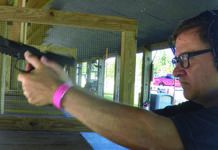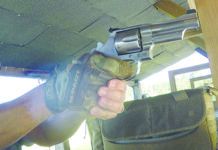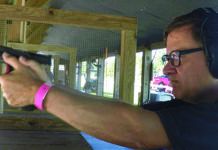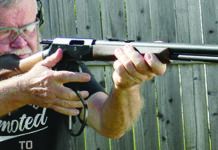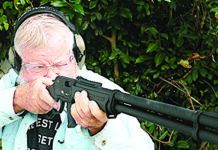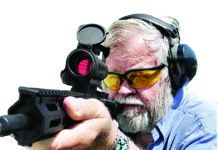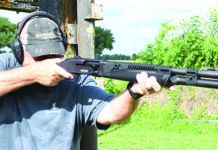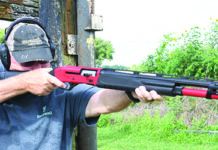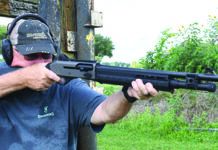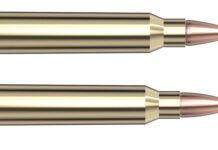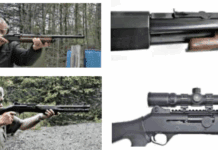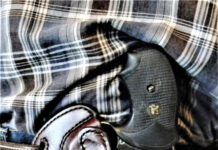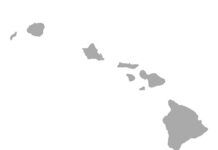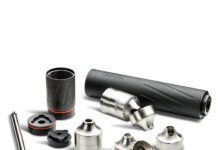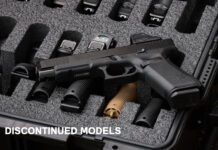The ammo development program at Winchester had been a closely guarded secret. The goal: to make a suped-down version of the 10mm Auto.
When the FBI began testing the 10mm, the agency found that a 180-grain bullet with velocities between 950 to 1,000 fps had great defensive potential. But the 10mm Auto, introduced in 1983, was too hot and dealt the shooter too much recoil for practical law enforcement use. What was needed, essentially, was a shortened 10mm cartridge that would fit in a smaller pistol platform-that is, S&Ws 9mm frames. Also, the cartridge needed to deliver a 180-grain payload at 950 to 1,000 fps with chamber pressures under
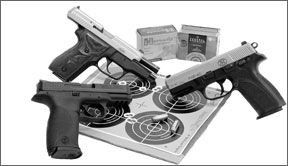
35,000 psi, the established ceiling for the 9mm.
The result was the .40 S&W, which Smith & Wesson and Winchester teamed up to introduce in 1990. Though big-bore critics of the time derided it at the time as “Short & Weak” or “Short & Wimpy,” the .40 came along as law enforcement was beginning to switch from revolvers to autoloaders.
Still, its a curious choice for the average LE or concealed shooter, because the .40 S&W cartridge is a high-pressure round that delivers a sharp recoil pulse. It pushes a medium to heavy projectile at high velocity, and this in turn pushes the slide back sharply. While it is supposed to occupy the middle ground between the 9mm and the .45, it is a much more difficult cartridge to shoot well than either of those rounds.
So we were curious how the .40 S&W would fare when packaged in concealable 4-inch-barrel guns. Our test guns were:
-
The USA-made FN Herstal FNP-40 with a 4-inch barrel, stainless steel slide and black polymer body, $695. It was a DA/SA gun similar to one we tested in December 2006, which came with 10-round magazines and standard sights (Model 47837). This gun, Model 47839, included 14-round magazines and Trijicon night sights, which upped the price.
-
Likewise, we tested a Smith & Wesson M&P40 No. 209000 in the August 2006 issue, putting it head to head with a Springfield XD 45. This time, we wanted to see how it fared head to head against other .40s in a slightly different configuration. This test gun was the 209200 unit, which lacked an internal lock. But it carried the same $640 MSRP as the 209000, and like the earlier gun, it also came with two 15-round magazines and a standard Novak Lo-Mount rear sight. Our guns tag price was $495.
-
The SigArms P229 SAS (Sig AntiSnag) is a SigArms Custom Shop item. This limited-production P229 has been dehorned and is marketed by the company as “ideal for concealed carry.” The SAS pistol utilizes the DAK trigger system (DAK stands for Double Action Kellerman, after the designer of the SigArms DAK system), and features a smooth stainless-steel slide with a front SigLite Night Sight and a contrast rear sight over a black hard-anodized alloy frame with rounded trigger guard and dust cover. The SigArms P229 SAS comes with the new Sig Sauer pistol Custom Shop Grips, which we cover in some detail below. Our test gun was $995.
We got all of our guns and ammunition at Fountain Firearms in Houston, www.fountainfirearms.com, and the prices reflect the shops retail costs.
How We Tested
Our test ammos for this comparison were Hornadys Custom .40 S&W 180-grain JHP/XTP No. 9136, Federal Premium .40 S&W Personal Defense Low Recoil 135-grain Expanding FMJs No. PD40CSP2 H, and Sellier & Bellots .40 S&W 180-grain full metal jackets.
Hornadys published ballistics for the 180-grain load fell short in our testing, with a muzzle velocity of 950 fps and energy of 361 foot-pounds in a 4-inch barrel. Instead, our velocity readings were around 80 fps lower across the board (M&P40, 881 fps; FNP40, 877 fps; and P229SAS, 860 fps).
The Czech firm Sellier & Bellot claims that its 180-grain FMJ No. SBA04001 load develops 968 fps at the muzzle (4-inch barrel) with 375 foot-pounds of energy. The MP40 came closest to that mark, notching a 962 fps reading. The other two guns also showed much smaller velocity reductions with this load than the others (FNP40, 934 fps; and P229SAS, 903 fps).
The Federal load likewise showed significantly lower-than-published velocities in two guns. Federal lists the Expanding Full Metal Jacket (more on the EFMJ in a minute) 135-grain load as running 1200 fps at the muzzle of a 4-inch barrel, which the MP40 approached with an 1171 fps reading. The other two guns, however, suffered significant speed reductions (FNP40, 1126 fps; and P229SAS, 1080 fps).
The EFMJ is marketed to law-enforcement agencies that dont permit hollowpoint ammunition. The design combines a scored full metal nose over an internal rubber tip that collapses on impact. Federal claims the hollowpoint never fills with barrier material, and its lead core at the base maintains weight retention. Also, the round has low-flash propellant for low-light tactical use, and as its chronograph readings suggest, it pops out high velocities with low recoil. Slugs we recovered from barrier material showed massive expansion, with some jacket separation.
To assess accuracy with our test rounds, we shot the guns outdoors at Hot Wells Shooting Range in northwestern Houston. We placed the guns on sandbag rests and shot targets at a distance of 15 yards, firing five-shot groups onto Caldwell Orange Peel 4-inch bullseye targets (www.caldwellshooting.com). Chronographing was performed by an Oehler 35P unit.
We also shot each pistol out of a two-handed combat stance onto a B-21XR 50-foot silhouette target available from Law Enforcement Targets, Inc., www.letargets.com. The B-21 is a human silhouette with a 5-ring in center mass.
We moved the target in to 7 yards and fired 12 rounds as fast and as accurately as possible, which made a perfect score of 60. In this test the FN lead the way with 58 points, followed by the Sig with 57 and the S&W with 52 points. We expand on overall shooter comfort with each of the guns below:
FNH USA FNP-40
Stainless DA/SA
.40 S&W No. 47839, $695
FNH USA is the sales and marketing arm of FN Herstal, S. A., Belgium, a large supplier of defense, law enforcement, and commercial firearms.
The FNP-40s high-capacity polymer frame has a beveled magazine well; ambidextrous manual decocking lever; reversible magazine release; hammer fired double-action/single action (DA/SA) mechanism; a firing pin safety, and optional magazine disconnect. Each FNP features a stainless-steel side available with a matte-black industrial tool coating or matte stainless finish. Our gun had the latter finish.
Elsewhere, the frontstrap and trigger guard are checkered, and FNH provided interchangeable arched and flat backstrap grip adapters, dovetailed front and rear sights, and an integrated rail system that accepts tactical lights or lasers. The factory says the FNP-40 also comes with three high-capacity magazines, a lock, and a hard storage case. But our gun came with only two magazines.
Important dimensions included an OAL of 7.4 inches with a sight radius of 6.0 inches. The frontstrap measured 2.3 inches in length, with the backstrap going 3.3 inches. It weighed 26.7 ounces with a 14-round magazine in place. The maximum grip circumference was either 5.5 or 5.8 inches, depending on which backstrap panel was in place.
From the bench, the FNP-40 printed its best five-shot groups (1.6 inches) with the Federal Premium Low Recoil 135-grain Expanding FMJs, followed by Sellier & Bellots 180-grain full metal jackets (2.3 inches) and Hornadys 180-grain JHP/XTPs (2.7 inches). That was on par with the Sig using the EFMJs and ball ammos, and better than the MP40 with the Federal and Hornady loads.
Pluses of the gun included:
-
Overall finish quality;
-
Excellent nighttime visibility with the greenish Trijicon night sights;
-
A smooth, rounded comfortable trigger shoe;
-
A crisp 4.2-pound single-action pull;
-
The adjustable backstrap system;
-
And a single-slot front rail for attaching a flashlight.
On the downside, we noticed:
-
Visible file scratches on the top of the barrel;
-
The decock levers stuck out too far on both sides, in our opinion, and the leading edges of the levers were sharp and would require breaking;
-
The frame gaps to accommodate the decock levers were too large, inviting crap to fall into them;
-
The top of the grip felt square in the web of the shooting hand, which caused some irritation of the skin in that area;
-
For cleaning, the inside of the gun is a Q-Tip nightmare, with protruding spring ends that would snag cotton fibers;
-
And the guns magazines didnt fall free.
In more detail, we both liked, and didnt like the trigger. The initial trigger pull weight in double action was 9.8 pounds, and the double-action pull had three phases. The heaviest take-up phase included the hammer moving back, then the pull stacked before the gun fired, then there was a spongy let off. During the pull, the shape of the trigger tended to let the finger slide down to the bottom, where it nearly pinched the trigger finger against the inside of the guard. In single action, the 4.2-pound pull and the accompanying 2.5-inch trigger span (versus 2.8 inches for the DA pull) didnt cause these problems. The outer surface of the hammer was grooved, making it easy to thumb back for first-shot single action.
As we noted, the 14-round magazines with polished stainless steel bodies didnt drop free like the Sigs and S&Ws did, but that requires more explanation. The release button was finicky, allowing the magazines to release, but not clear the frame, when the button was pushed on the frame side or bottom of the button. But push the front edge of the release, and the magazines popped right out. Also, the shiny stainless magazines were harder to load as they got full. Up to 10 rounds, no problem. But loading between 10 and 12 rounds required more effort, and loading 13 and 14 was difficult, and almost not worth it. Still, we experienced no failures to fire, feed, or eject.
The two decocker levers were in reach of the thumbs, but as we noted in the previous review of this gun, for those accustomed to shooting with the strong-hand thumb against the side of the frame or atop a safety lever, they had to be careful not to touch the decocker. Once we learned to keep the strong-hand thumb away from the side of the pistol, decocking the FNP-40 unintentionally was not a problem.
Smith & Wesson M&P40
No. 209200 .40 S&W, $495
The S&W website lists 10 different configurations of the M&P40. The 10-round versions are California compliant and begin with a “1” in the companys six-digit nomenclature. The night-sight versions add more than $100 to the M&Ps price tags, with guns so equipped selling for $743.
The striker-fired gun carries 15+1 rounds in its 7.5-inch-long and 5.5-inch-tall size. Sight length is 6.4 inches, with a barrel length of 4.25 inches. Without a magazine, the gun weighs 24.25 ounces, and with a full magazine and chamber, it tips the scales at 35.85 ounces. The companys published trigger-pull weight was 6.5 pounds, which our scale agreed with. The Zytel polymer frame was stippled on the backstrap, frontstrap, and magazine release, and the stainless steel slide and barrel were coated with a hard matte-black Melonite finish. The front sight ramp and dot were dovetailed into the slide, and the rear sight was a steel Novak Lo-Mount Carry unit. Tritium sights are also available.
Among this guns plusses were the following:
-
$200 cheaper than the FN and $500 cheaper than the P229 SAS;
-
Overall impressive fit and finish;
-
Ambi slide release allowed for both left- and right-hand operation, and the magazine release is reversible, which also helps lefties;
-
The Novak sights were easy to read and put on target;
-
The option grips allowed us to customize the gun for different hand sizes;
-
There is an optional ambidextrous manual safety lever now offered (one of the requests we had in our first review);
-
And the frame includes an accessory rail.
Its negatives included:
-
Very sharp points on the front of the slide under the guide rod;
-
Hollow roll pins detract from cosmetics;
-
We were unable to extract the grip tool from its storage space, so we couldnt change grips;
-
And the M&P40 was the most difficult of the guns to field-strip.
In more detail, the trigger face was hinged to deactivate the striker block safety. The rear of the trigger included a stop that met with a ridge on the inside of the trigger guard. The effect of the trigger pull was that the initial take-up was disengaging the safety, then there was some creep and additional weight, then a bit of travel before a clean break at 6.5 pounds.
From the bench, the M&P40 printed its best five-shot groups with Sellier & Bellots 180-grain full metal jackets (2.0 inches), followed by the Federal Premium Low Recoil 135-grain Expanding FMJs (2.5 inches) and Hornadys 180-grain JHP/XTPs (2.9 inches). That was better than the Sig and FN using the ball ammo, but behind the other two guns with the Federal and Hornady loads.
The magazine release was a push-button design that could be changed to operate from the right side if desired-a boon for lefties. Also, slide releases found on each side of the pistol gave it an ambidextrous operation the other guns lacked. The releases were small and fit tightly against the frame. The slide lock lever was placed further forward, directly above the trigger. In both cases, the levers didnt detract from the guns concealability like the decock levers on the FN did.
Elsewhere, the M&Ps external extractor helped the gun function without flaw. The rear of the slide included a wavy pattern that provided a texture with which to grip the slide. The rear Novak low mount sight with two white dots was adjustable for windage only. The windage adjustment came in handy since the gun shot low and to the left out of the box. The barrel hood offered a hole at the rear that extended into the breech face for visual inspection of the chamber. The ejection port in the slide was very large, exposing a portion of the barrel hood on the left side as well. The well built blued magazines were numbered 4 to 14 on the right side and 5 to 15 on the left side. We had trouble loading only the last two rounds into the stack.
SigArms P229 SAS
.40 S&W, $995
As we noted above, the SAS (Sig AntiSnag) is a Custom Shop limited-production P229. Its part of a well-regarded family of 229s
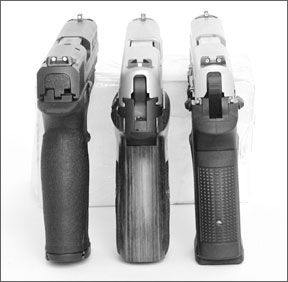
that include laser-equipped models ($1159), other DAK models (around $850), Short Reset Trigger (SRT) models ($1067). Our SAS, available only in .40 S&W, carries an MSRP of $1,020-not far off the Fountain Firearms asking price.
The gun carries 12+1 rounds in its 7.1-inch-long and 5.4-inch-tall footprint. Sight radius is 5.7 inches, with a barrel length of 3.9 inches. With a loaded magazine, the gun weighs 32 ounces. The companys published trigger-pull weight was 6.5 pounds, but our scale said 8 pounds start to finish. The aluminum-alloy frame featured horizontal grooves on the frontstrap and magazine release, with a smooth wood backstrap. The edges of the stainless steel slide have been broken and rounded, and the front sight ramp was dovetailed into the slide.
Among this guns pluses were the following:
-
Very attractive fit and finish, particularly the dehorn job on the slide;
-
Almost all sharp edges removed;
-
Very easy to field strip.
-
Most attractive gun in the test, with two-tone metalwork and wood grips;
-
The magazines were the easiest to load to full capacity;
-
And, operation was flawless.
The negatives we found were:
-
The gun shot high;
-
The fat wood grips print when under clothes;
-
The front edge of the magazine also prints under clothing;
-
The trigger seemed to stack resistance toward the end of the pull;
-
The rear sight lacked visible dot references for night shooting;
-
And it cost a lot-$300 more than the FN and $500 more than the M&P40.
The trigger bears more description, because it cycles somewhat like a double-action revolver trigger. After the SAS fires and the trigger moves forward, theres a reset point about halfway to the trigger at rest position. The trigger pull from this reset point is 8 pounds. If the trigger is released all the way forward, this engages the primary trigger reset. In firing the gun, its possible to pull the trigger to the stop with about 0.1 inch of rearward travel, then let off, and leave the hammer at half-cock. Then the shooter can engage the trigger from that point rearward with a cleaner, shorter break. We found it difficult to fire the gun accurately with the full trigger stroke.
The wood grips are polished smooth on the backstrap and cut-checkered on the sides. Some bloggers have said this allows fabric to slide over the gun butt and reduce printing, but the grips girth offsets any gains the smooth butt handle might offer, in our view. Also, the lack of checkering on the backstrap feels nice, but with sweaty hands, the grip becomes slick and hard to index properly shot to shot, because the gun twists in the hand. Also, the joint where the beavertail meets the grip on the left-hand side was raised slightly, which caused some irritation to the web of the right shooting hand.
The SAS grips 1.6-inch width and 6.0-inch girth are substantially larger than the others (S&W: 1.1 inches and 5.7 inches; FN: 1.3 inches and 5.5 inches) yet the shooter doesnt gain capacity as a result. We shot our practical test with only 12 rounds, because that would have otherwise penalized the SAS, whose magazine capacity was two rounds fewer than the FN and three rounds fewer than the M&P40. However, we recognize that shooters with bigger or slimmer hands might like the wood grips better than we did.
As we noted above, the rear sight lacked a glowing tritium insert, but the front sight had one. We would have preferred that both the front and rear sights be treated this way.
GUN_REPORT_CARD_CARRY-1007.pdf




